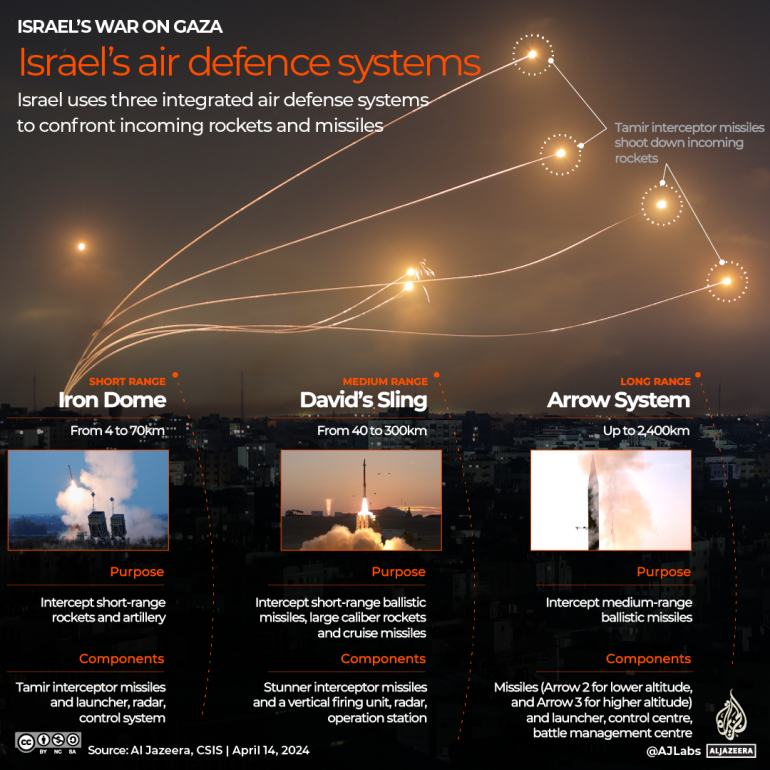In the latest escalation between Hezbollah and Israel, more than 569 people, including 50 children and 94 women, have been killed in Israeli air strikes across Lebanon since September 23.
In retaliation, Hezbollah launched rocket attacks into Israel, with some projectiles directed at Israeli airbases.
See our live tracker for the latest updates on the escalating situation.
The exchange of attacks between Israel and Hezbollah has been going on for almost a year since October 8, when Hezbollah began launching attacks on Israel in solidarity with the Palestinian people trapped in the Gaza Strip as Israel waged war on the enclave.
Israel has attacked Hezbollah nearly four times that of the Lebanese group, tallying more than 8,300 attacks along the 120km (75-mile) border.
Hezbollah, which was formed in 1982 to fight Israel’s invasion and occupation of southern Lebanon, says it will stop attacking Israel if its assault on Gaza stops. Its leader Hassan Nasrallah says the group does not seek an expanded war but is prepared to match Israel’s aggression.
Regarded as the most battle-hardened nongovernmental fighting group in the region, Hezbollah fought a 34-day war against Israel in 2006 that was widely seen as a strategic and military failure for Israel.
Some Israeli leaders have pledged to remove Hezbollah from southern Lebanon, even by force.
The attacks
According to the Armed Conflict Location and Event Data (ACLED), at least 10,214 attacks were exchanged between Israel and Hezbollah and other armed groups in Lebanon from October 7 to September 20.
About 81 percent of these attacks – 8,313 – were carried out by Israel, which killed at least 752 people in Lebanon.
Hezbollah and other armed groups were responsible for 1,901 attacks that killed at least 33 Israelis.

In addition to Hezbollah – which mostly bore the brunt of the hostilities – other parties involved in attacks against Israel include Lebanese al-Fajr Forces and Amal Movement as well as Hamas’s Qassam Brigades and Palestinian Islamic Jihad’s al-Quds Brigades, both armed wings of Palestinian groups with a presence in Lebanon.

Israel has attacked these locations in southern Lebanon the most:
- Aita al-Shaab – 409 attacks
- Naqoura – 313 attacks
- Kfar Kila – 312 attacks
- Hula – 298 attacks
- Khiam – 254
Groups from Lebanon attacked these locations in northern Israel the most:
- Kiryat Shmona – 166 attacks
- Metula – 111 attacks
- Margaliyot – 103 attacks
- Al-Manara – 92 attacks
- Shtula – 83 attacks
On September 17, thousands of pagers exploded across Lebanon, killing at least nine people and injuring some 3,000, including the Iranian ambassador to Lebanon.
The attack last Tuesday, which targeted members of Hezbollah, caused chaos in civilian areas and overwhelmed hospitals.
Hezbollah blamed Israel for the near-simultaneous pager blasts, saying it would get “its fair punishment”, according to a statement released by the Iran-backed group which has been exchanging almost daily cross-border fire with Israel for almost a year.
There was no comment on the blasts from the Israeli military.

Israel’s arsenal
Israel holds the most advanced missiles in the Middle East, many produced domestically, but most of its precision-guided missiles are from the United States.
According to the Center for Strategic and International Studies (CSIS), much of Israel’s capabilities are short-range tactical systems, including the Popeye, Extra and Gabriel missiles. Among its long-range missiles are Jericho 2 and Jericho 3 ballistic missiles with ranges of 1,500-3,500km (930-2,175 miles) and 4,800-6,500km (3,000-4,000 miles), respectively.
Also, despite not officially acknowledging it, Israel is believed to possess at least 90 nuclear weapons.

To confront incoming rockets and missiles, Israel uses three integrated air defence systems: the Iron Dome (short-range), David’s Sling (medium-range) and Arrow (long-range).
The Iron Dome was originally billed as providing city-sized coverage against rockets with ranges of 4-70km (2.5-43 miles), but experts say it has been expanded.
David’s Sling, produced by Israeli weapons giant Rafael, can intercept rockets and missiles with a range of 40-300km (25-186 miles). The Arrow series, led by the Arrow 3 interceptor, has an estimated fly-out range of up to 2,400km (1,491 miles).

Hezbollah’s arsenal
Hezbollah is considered to be one of the world’s most heavily armed non-state actors, with an estimated rocket arsenal of 130,000, according to CSIS.
On October 19, Israel’s Institute for National Security Research estimated that Hezbollah had 40,000 Grad-type missiles with a short range of 15-20km (9-12 miles).
A step up are 80,000 longer-range missiles, including the Fajr 3 and Fajr 5 ballistic missiles, with a range of 100km (62 miles).
Finally, there are about 30,000 Zelzal or Fateh-110 missiles with a range of 200-300km (124-186 miles) – the longest-range weapons in Hezbollah’s inventory, capable of reaching southern Israel.

EMEA Tribune is not involved in this news article, it is taken from our partners and or from the News Agencies. Copyright and Credit go to the News Agencies, email news@emeatribune.com Follow our WhatsApp verified Channel


